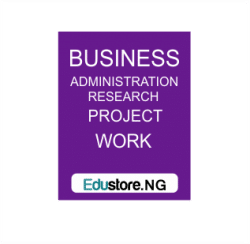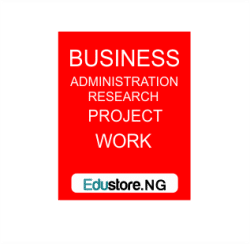The Impact Of Communication On Job Performance In Private Organizations (a survey of selected firms in rivers state)
ABSTRACT
Communication is bound to happen in any organization where information is passed on from one person to the other; through the use of both verbal and non-verbal means. Uniliver PLC river state, like every other organization uses communication in their daily activities; in interactions between superiors and subordinates, as well as among colleagues, both formally and informally amidst some challenges. This study investigated the role of effective communication on organizational performance using Uniliver Plc as a case study. Specifically, the study examined the communication systems available in Uniliver Plc and measured the employees’ performance. In addition, it determined the relationship between effective organizational communication and employee performance. It also identified the channels of communication considered by employees to be the most useful. Finally, barriers and breakdowns in the communication systems of Uniliver Plc were also identified. Primary data was adopted. Simple random sampling was used for the selection of 200 respondents. Mean, correlation results were adopted in the analysis. From the results, the communication systems frequently used include face-to-face, telephone, written memos, email/internet and grapevines, with the most useful channel of communication being face-to-face. Uniliver Plc employees also largely perform well. Selective listening, distraction, time pressure, communication overload, information distortion, rationalization. Finally, various employees’ performance indicators are found to correlate with varying measures of effective organizational communication. Employee performance can be further enhanced if bottlenecks in the communication systems are either removed or kept at their least. Particularly, information distortions caused by omissions and exaggerations must be addressed both by management and employees to improve clarity in communication.
CHAPTER ONE
INTRODUCTION
1.1 Background of the Study
All organizations, both public and private entities rely on some form of communication to send their messages across to their target audience, or inform their target audience of the mission and vision of their entity. Employee mostly hypes performance at the work place when effective communication is at its ultimate. For instance, when the information about an organization’s policies and procedures are at its optimum level with openness and accuracy; and also when the information provided is adequate, factual and has good feedback (Kacmar et al., 2003; Neves & Eisenberger, 2012).
Meanwhile, only sizeable modern age organisation has placed value on effective work place way of communicating. It is assumed by some management members that, communication is the simplest task for everyone to execute but research has shown that communication thus make and unmake the existence of an organisation. In most organisations, managers often leave that aspect of effective communication to the human resource department as their focus only reaches for the operational activities. In uniliver PLC for example, the managers only concentrate on target achievement thereby forgetting that free flow of information and how well the staff understand these information dissemination boost their moral to work harder in maximizing revenue. Likewise there becomes huge problem when managers within organisation always assume that they have had sufficient communications with their staff just by way of instructing them on their daily schedules. According to Anchor (2009) and Eisenberger & Stinglhamber (2011), two-way communication has positive impact on workers who perform profitably at work. They form some kind of belief pertaining their work which intends satisfy the socio-emotional. Relating this to the study done by Eisenberger & Stinglhamber (2011) and Rhoades & Eisenberger (2002), employees are able to determine the organisations’ readiness to appreciate and reward effective and efficient performance by workers.
Puth (2002) opined that management with an organisation have resorted to use workplace journal or publication to dialogue with employees, nonetheless major related channels of communication are not used effectively. He mentioned that in-house publications may not have any strategic bearings to sustain an organisation rather, encouraging two-way communication does the thrill to dominate workforce. Puth (2002) perceived that performance within an organisation could be improved significantly by way of sharing information with employees and involving them in policy making. However this recuperates general employee satisfaction and productivity within an organization. In some cases the communication gap that exist between managers and employees makes them to generally sense not trustworthy, respected or valued to be responsible in their field of work. In his studies, it was argued that the largest valuable resources within an entity are the employees; therefore it is the responsibility of managers to encourage two-way flow of information to optimize organization’s performance as well as employee productivity. This makes communication very essential for all stakeholders as it assimilates most managerial purposes. Ethically, communication is needed internally to initiate plans for expansion; to also consolidate resource in effective with less cost; to select, nurture and appraise members of an organization. Conversely, communication is needed externally to serve as awareness creation for management to do business with their stakeholders such as; suppliers, government agencies and many others. The essence of communication is very vital and cannot be left unattended; it is that king of mechanical system, which determines the growth of an organization in all aspect during this modern age. It is against this background that the study on effective communication on organizational performance is set to ascertain what pertains on grounds using a public institution as a case.
1.2 Statement of Problem
Employee Interaction is a principal and essential endeavor in organizations as stated by Harris & Nelson (2008). They further asserted that the sustainability of an organization is based on effective communication among employees and relationships develop based on effective communication. Working environments differs from all angles as well as their culture, economic and social development. In this context some of these organizations’ have cumbersome reporting lines, which are difficult for the employee to abide; such as conflicting authorities, and obligations thereby making some subordinates become answerable more than a superior. Intra- communication facilities such as intercoms and memos are mostly ignored by some organization and this deprives subordinates from knowing the vision and mission of an organization. Considering the problems stated above, the study intends to aid organizations by expounding on the way effective communication would improve employee performance.
Studies have shown that effective communication helps employees to coordinate activities, achieve goals. It is also vigorous in socialization, decision-making, problem solving and change-management processes. This again ensures that members of an organization or institution are working towards a common goal and purpose. Most organizations have challenges and continue to find the most effective channels for communicating with their constituents.
The absence of such a strategy or effective communication channel tends to under-utilize the expertise and vital information from the employees, which could be a critical input for formulating an effective communication strategy to reduce or eliminate apathy in performing their roles. To what extent do these communication gaps affect the work performance of employees and the organizational performance as a whole? The effect of poor communication on employees and the organization needs empirical evidence from the public sector. It is for this reason that this study is set to fill that gap in literature.
1.3 Objectives of the Study
The main research objective is to determine the function of successful communication on organizational performance using selected firms in Rivers State as a case. However, the specific objectives of the study are below;
- To examine the communication systems in Uniliver Plc.
- To measure the performance of employees using Uniliver Plc appraisal indicators.
- To determine the relationship between effective organisational communication and employee performance.
- To identify the most useful channel of communication from employee point of view.
- To identify barriers and breakdowns in the communication system of Uniliver Plc.
1.4 Research Questions
In order to attain the above objectives, the following research questions must be taken into consideration.
- What is the system of communication that exists at Uniliver Plc?
- What is the employee performance level at Uniliver Plc?
- What is the relationship between effective organizational communication and workers performance at Uniliver Plc?
- How does communication improve employee performance at Uniliver Plc?
- What are the barriers and breakdowns in the communication system at Uniliver Plc?
1.5 Significance of the Study
The research will provide meaningful information to the management of Uniliver Plc about efficiency, credibility, and economy of their communications policies, practices. The study will enable managers in Uniliver Plc to get awareness concerning the influence of effective communiqué and in what way ineffective communiqué has negatively affected employee performance and thus the study will suggest strategies towards improving communication to boast up employee performance in the firm.
Also, the study would aid students studying management to understand the theoretical background of effective and communication. It would empower students to takeoff well when establishing or managing an enterprise.
The study would be beneficial to academia, as it would provide empirical findings on communication systems and channels in public institutions. It would therefore serve as a reference point for future study and at the same time, fill research gap.
1.6 Scope of the Study
Due to resource constraints, the study was limited to the collection and analysis of data of mid to selected lower level employees of Uniliver Plc in the River state. The study also sought to uncover the level of internal communication within Uniliver Plc and how communication can be leveraged to improve employee morale and performance.
1.7 Organization of the Study
This study is organized into five chapters. Chapter one deals with introduction by focussing on background of the study, problem statement, objectives of the study, research questions, significance of the study, scope and limitation of the study as well as the study’s organization. Chapter two deals with literature review with the focus on reviewing various literatures on the impact of effective communication as a tool for improving employee performance. Chapter three deals with methodological procedures and research design, which includes data collection, sampling and the analysis of the data, collected. Chapter four presents and discusses the empirical results of the study. In chapter five, the summary, conclusions and recommendations of the study are provided.
DOWNLOAD COMPLETE WORK- For Reference Only: Materials are for research, citation, and idea generation purposes and not for submission as your original final year project work.
- Avoid Plagiarism: Do not copy or submit this content as your own project. Doing so may result in academic consequences.
- Use as a Framework: This complete project research material should guide the development of your own final year project work.
- Academic Access: This platform is designed to reduce the stress of visiting school libraries by providing easy access to research materials.
- Institutional Support: Tertiary institutions encourage the review of previous academic works such as journals and theses.
- Open Education: The site is maintained through paid subscriptions to continue offering open access educational resources.





